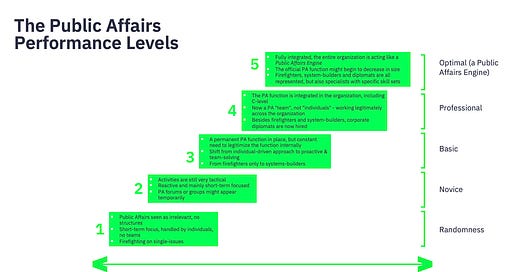Does a higher number of Public Affairs FTEs lead to better performance?
Some - surprising - early results from 20 performance tests
As I have written about a few times, I have developed a Public Affairs Performance Model, which I am currently testing.
And, as I now have completed a bit more than 20 performance tests, I can share a few preliminary results, which of course should be taken with some spoonfuls of salt, as its not a representative study, but rather “a test of a test” of 20 random types of organizations.
But I think there are some interesting tendencies to double click on. Before we jump in to the first one, remember to subscribe if you haven’t done so already - only content like this from my blog, no spam.
The Public Affairs Performance Model
First, it might be in place to elaborate a bit about the model. The Public Affairs Performance Model (PAP-Model) is developed to assess the Public Affairs performance of an organization. I have looked at many existing different (and clever) ways and methods to assess Public Affairs performance, but I think they are either too complex (and impossible to use for most organizations) or too simplified and superficial. So - of course - I thought I would create my own model, which should hopefully be both relevant for more organizations and easier to approach.
Through 50 questions the model will reveal a score for the Public Affairs performance. The final score will range from 1-5 (the higher the better performance) and so this score also equals the level of the organization in the Public Affairs Performance Model.
Below I have visualized and simplified how the model should be understood. Each Performance Level has certain characteristics, specific challenges and types of people.
Performance and team size
After a bit of context about the model, lets focus on the first tests. There are many interesting insights from the first 20 tests, but of course I cannot share all details as they on an individual base are confidential. But on an aggregated level, there are some interesting facets, e.g. the one I want to cover in this blog: The relationship between Performance Level and number of FTEs working with Public Affairs.
When you read media articles about lobbyism or Public Affairs you get the clear picture that more resources = more FTEs = higher performance, and thus there is an inequality angle built in to to most of these writings.
But this is both true, and maybe not always true. Based on the 20 first performance tests, the scores can be plotted like this.
During the tests I suspected that the level of performance increased with the number of FTEs - but only to a certain point. This is thought or observation is something I have talked a bit about on my podcast, but only based on a gut feeling. That is, once you get to a certain level or maturity of the function, you don’t necessarily need more people - sometimes it is actually the opposite.
The centralized decentralization
This trend depicted above is based on the assumption that the highest performing organizations actually work very decentralized, even though they might to the untrained eye seem centralized. The Public Affairs function can sometimes be almost successfully dissolved in to the organization. This means that the previous exclusive tasks of the Public Affairs function have now been almost entirely absorbed by the people in the organization.
This does not mean - at all - that the fewer FTEs, the better, as this is entirely dependent on the structures and processes in the organization. So if you meet an organization with only 1 Public Affairs pro claiming everything is just perfectly delegated to the rest of the organization, this is typically not true, as it is not only about delegating or decentralizing. It is of course much more complex than so.
Two key learnings after the 20 first tests
Number one is that the organization of Public Affairs can actually result in higher performance - and not always just more FTEs.
The second key learning is that among the 20 test organizations most were surprised of how low they scored, but not surprised once I elaborated on why they underperformed compared to others. Think about that for a minut.
Want to know the level of your Public Affairs performance? Reach out at www.anderskopp.com







